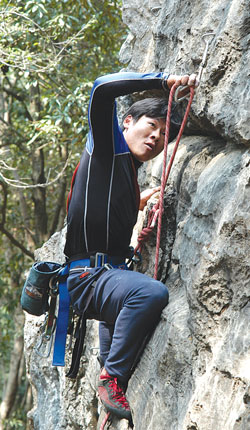|
|
"Safety first," says Dilip Kumar Rai, strapping himself securely into a harness and swinging onto a sheer 12m high rockface in the Nagarjun Forest.
Dilip inches up slowly, looking like nothing so much as a languid spider. In fact, he's concentrating intensely, exploring the surface of the rock for suitable footholds and handholds that will be strong enough to take his weight and help him move up. His friend Tej belays him and Dilip edges along, looping the rope through bolts already screwed into the wall. He's done this before, and pretty soon he's at the top of the wall waving down at us.
Rai and his friend Tej Khapangi, like other rock climbing enthusiasts, frequent the sanctuary, which is known for low limestone cliffs that are suited to beginners and experts. The friends are river guides by profession, and climb here and in Pharping for love of the sport, not because it's their job. "Once you get addicted to climbing, it's very hard to stop," grins Rai.
"Rock climbing is just catching on," says Padam Ghale, a pioneer rock climber in Nepal and a member of the original group that developed the Nagarjun route.
Compared to other countries, Kathmandu's routes may seem, well, puny, but they're great places to start. "Rock climbing in Kathmandu and Nepal is perfect for beginners," explains Sunar Gurung, president of the Nepal Mountain Guide Association. "Low grade walls and short route lengths allow newbies to learn and perfect the basics." Ghale and Gurung have been climbing for almost 25 years, exploring and building climbing routes in and around Kathmandu.
 The wall at Nagarjun offers 17-18 climbing routes, with varying levels of difficulty, from 5 to 7A grades. There are easy straightforward climbs, but also a couple of tricky overhangs that more advanced climbers can have some fun with.
The wall at Nagarjun offers 17-18 climbing routes, with varying levels of difficulty, from 5 to 7A grades. There are easy straightforward climbs, but also a couple of tricky overhangs that more advanced climbers can have some fun with.
The climbing at Pharping is harder, as the walls are steeper, there are numerous overhangs and larger gaps between the bolts. Sheshnagar nearby offers a
6A+ route, while Hattiban offers six routes at the 6A-6B+ grades. The route at Sheshnagar is not very popular, since most people find it too difficult and a little dangerous.
For young beginners, there is a new artificial indoor wall at the Mountaineer's Memorial Centre in Kakani. This is certainly different from the genuine outdoors experience-the texture you feel is stone and cement, rather than the gritty, sharp limestone and hand- and footholds protrude out from the wall. The 3-5 grade climbs are also where the National Mountaineering Association offers courses.
You meet a small but diverse group of people at Nagarjun and Pharping-trekkers, mountaineers and extreme sport junkies, as well as diplomats, marines, and security workers. For a relatively safe activity in a mountainous country, there seem to be few Nepali takers.
"People think rock climbing is just for mountain climbers," says Endra Rai of Kathmandu's Nodan Club. "Sure, it's the first step to climbing mountains, but it is a challenging and rewarding activity in and of itself too. It's a social sport and a great way to promote team building and trust," he adds. Nodan Club runs personality and professional development courses using extreme sports such as climbing, canyoning, and kayaking as a way of personality development.
 If you're a climber tired of Nagarjun head for Tarebhir on Shivapuri-it's difficult to reach and offers tougher climbs. Outside the Valley, the nine routes at Bimalnagar in Dumre are also popular, and go from a low grade 10m route for beginners to a much harder 60m route for seasoned climbers. The walls at Chewang in Solu and Thame in Khumbu are usually used by experienced climbers to acclimatise for high altitude exeditions.
If you're a climber tired of Nagarjun head for Tarebhir on Shivapuri-it's difficult to reach and offers tougher climbs. Outside the Valley, the nine routes at Bimalnagar in Dumre are also popular, and go from a low grade 10m route for beginners to a much harder 60m route for seasoned climbers. The walls at Chewang in Solu and Thame in Khumbu are usually used by experienced climbers to acclimatise for high altitude exeditions.
Nepal's spectacular landscape has enormous potential for excellent rock climbing. But ironically, in a country known for, well, mountains and climbers, there is very little support for the sport, either financial or moral.
The Ministry for Education and Sports does not even recognise rock climbing as a sport, says Ngawang Nima Sherpa, head instructor at the NMA. The association says that while its climbing permit royalties do not generate enough funds to explore new regions and develop routes, it does receive support from overseas. The Yves Pollet Villard Foundation, for example, sponsors instructor upgrade courses and rescue training courses for climbers.
Rock climbers will tell you that there are few sports like this where your mind and body are in perfect harmony, and which combine stretching, weight-bearing, and cardio.
"Rock climbing is like meditation," says Padam Ghale, "Both my mind and body need to be firmly under control and when I'm finished, I feel relaxed and at peace."



